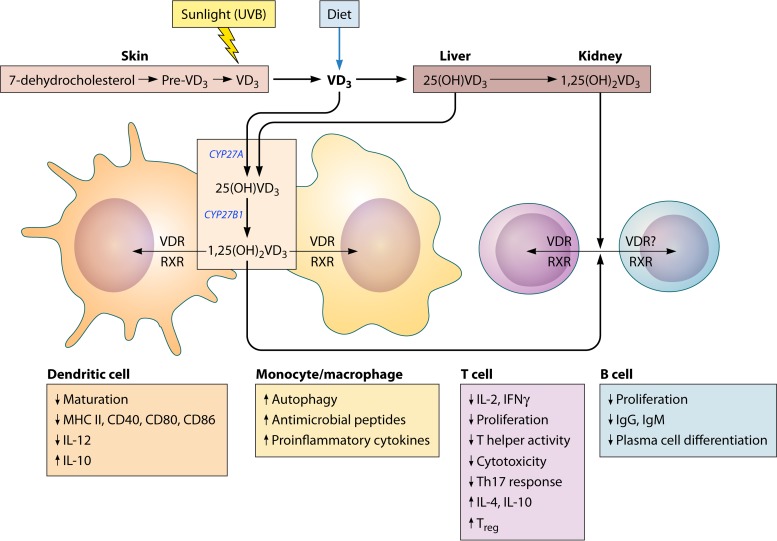FIG 4.
Vitamin D metabolism and cells of the immune system. Vitamin D3 (VD3) (cholecalciferol) is primarily acquired preformed in the diet or synthesized in the skin through the action of UVB radiation in sunlight from 7-dehydrocholesterol. VD3 is metabolized first in the liver to 25-hydroxyvitamin D3 [25(OH)VD3] and then in the kidney to the most physiologically active metabolite, 1,25-dihydroxyvitamin D3 [1,25(OH)2VD3]. VD3 can also be metabolized by cells of the immune system (e.g., dendritic cells and macrophages) to 25(OH)VD3 and 1,25(OH)2VD3 through the action of the enzymes CYP27A and CYP27B1, respectively. 1,25(OH)2VD3 acts on immune cells in an autocrine or paracrine manner through binding to the nuclear vitamin D receptor (VDR). Upon binding with 1,25(OH)2VD3, VDR heterodimerizes with nuclear receptors of the retinoic X receptor (RXR) family, and the complex binds to VD3 response elements in the promoters of VD3 response genes. CYP27B1 and VDR are upregulated in cells activated through TLR2, TLR4/NF-κB, and IFN-γ/STAT1. VD3 has a largely suppressive effect on the adaptive immune system. Markers of dendritic cell maturation, activation, and antigen presentation are downregulated by exposure to 1,25(OH)2VD3. In particular, IL-12 production is diminished, leading to reduced Th1 differentiation, and suppressive cytokines such as IL-10 are upregulated. T lymphocytes show evidence of reduced proliferation, cytotoxic activity, and effector cytokine expression and increased regulatory function through increased regulatory T cell (Treg) and Th2 differentiation and IL-4 and IL-10 production. It is unclear if B cells express VDR or if their function is modulated indirectly through the reduced activity of antigen-presenting cells or reduced T cell help. B cells show reduced proliferation, differentiation to plasma cells, and immunoglobulin secretion. In contrast, monocytes and macrophages exposed to 1,25(OH)2VD3 have increased proinflammatory properties and produce antimicrobial peptides that are important for the innate immune response (211).

